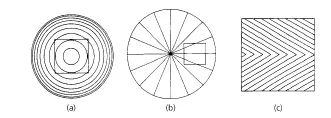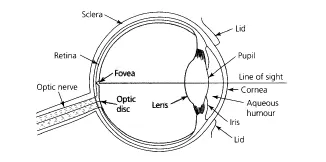![]()
1
Introduction to perception
Introduction
Sensation and perception
Why do psychologists study perception?
The visual system
Summary
Introduction
As you read the text on this page, you are demonstrating your extraordinary powers of sensation and perception. You are able to identify letters and words at a remarkable speed and, if you glance up occasionally, you will be able to take in the sights and sounds and movements of objects and people in the room you are sitting in.
The aim of this chapter is to explain the nature of perception and to show why psychologists are interested in trying to explain perceptual processes. It will also give you an idea of how the visual system functions.
Sensation and perception
Sensation refers to the responses of sensory receptors and sense organs to environmental stimuli. Perception, on the other hand, is a process which involves the recognition and interpretation of stimuli which register on our senses. Someone who is studying sensory processes is likely to ask questions such as ‘How is electromagnetic radiation registered by the eye?’ Whereas a psychologist interested in perception is more likely to ask ‘How can you recognise that object? How far away do you think it is? Where is it in relation to other objects that you see around you?’ In other words, perception relates to how we make sense of our environment and sensation refers to the basic stimulation of the sense organs. Imagine that you hear someone play a few notes on the piano—the qualities such as pitch, tone and loudness register as sensations but, if you recognise that the notes form a tune, then you have experienced a perception. Most psychologists would agree that the boundary between sensation and perception is rather fuzzy. It can be difficult to decide just how complex stimuli need to be before they involve perception and how much interpretation is required before sensation becomes perception .
Why do psychologists study perception?
We usually use our senses with such ease that it may be difficult for you to understand that there is anything for psychologists to explain. Imagine that you are in a student common-room during a fairly quiet time. You will be able to recognise friends as they come in. You will be able to smell the coffee in their cups. You will be able to hear and understand the news headlines coming from a television set in the corner of the room. Perception just seems to happen—you do not appear to be expending much effort on it. Consider some situations where your quick perceptions can keep you from harm. They can alert you to a car that comes hurtling round a bend in time for you to jump back out of danger. They can provide you with information that makes you step back from an uncovered manhole in the pavement, so avoiding a fall and serious physical harm. The apparent immediacy of perception, however, belies the complex processes that are happening behind the scenes. There is an old saying ‘Seeing is believing’, but this is misleading. Look at the drawings in Figure 1.1 In spite of what your senses tell you, A, B and C are all perfect squares. Perception amounts to rather more than meets the eye!
Psychologists are interested in trying to understand some of the hidden complexities of perception. They ask questions such as:
- How are coherent perceptions derived from the myriad inputs being received all the time by sensory receptors?
- How are sensory data processed to provide mental representations of our environment?
Figure 1.1 Some examples of drawings that create misperceptions
- How important are factors like past experience in determining our perceptions?
These questions will be addressed in later parts of the book, but you will find that psychologists do not all agree on the answers.
Progress exercise
Explain briefly in about 50 words what is the essential difference between sensation and perception.
The visual system
Perception involves all the senses but the theories that we will discuss in later chapters are concerned with visual perception. Vision is arguably the most important sense for humans and much more research has been conducted by psychologists into the area of visual perception than into any other perceptual systems.
In order to understand more about visual perception, it is worth knowing something about the way in which the visual system is constructed, although it is beyond the scope of this book to provide a highly detailed account. You will find excellent descriptions in more specialised textbooks (some suggestions are given at the end of this chapter).
Our sense organs are able to receive electromagnetic energy from the environment and to convert it into electrical activity in the nervous system. In vision, the environmental energy is in the form of light. We will trace the progress of the light signal through the visual system,
Figure 1.2 Diagram to show the structure of the eye
noting along the way the various factors that can alter or impede the visual experience.
The structure of the eye
Incoming light from the visual stimulus needs to be brought into focus on the rear surface of the eyeball; it is at the cornea (see Figure 1.2) where this process starts.
Cornea
The cornea helps to bend incoming light rays so that they fall directly on to the retina at the back of the eyeball. In some people the cornea is misshapen, causing an astigmatism which will give rise to blurred vision. Astigmatisms can be corrected using glasses but need to be detected early in childhood because they can otherwise lead to abnormal neural development. The cornea cannot be nourished by blood-vessels because they would block incoming light. Instead, it is provided with oxygen and nutrients by the aqueous humour—a watery liquid that fills the chamber immediately behind the cornea. This liquid is replenished continually but the canal through which this recycling occurs can become blocked, giving rise to a buildup of pressure called glaucoma. This can cause blindness if it is not detected quickly but can be easily treated.
The sclera which you perceive as the white of your eye is opaque and ensures that light can only enter via the cornea. However, you know from your own experience that you have to function under a wide range of lighting conditions and, when it is very bright, the cornea would let in far too much light for efficient vision.
Iris and pupil
The visual system deals with this problem by having a mechanism which controls the amount of light that can enter at any one time. This mechanism consists of a ring of coloured muscle called the iris. The pigmentation is important in restricting incoming light, and darker irises (e.g. dark brown) are usually more efficient than paler ones (e.g. light blue). In the middle of the iris is the pupil which is simply a hole through which light passes. The muscles of the iris are capable of constricting (i.e. making the pupil smaller) or of dilating (i.e. making the pupil bigger). When the light is bright, the pupil can contract to as little as 2 mm. in diameter but, in dim light, it can dilate to more than 8 mm.
You can demonstrate this easily with a friend or fellow student. Turn down the lights, leaving enough light so that you can see your friend's pupils. You will notice how large the pupils appear under these conditions. Shine the beam of a torch into your friend's eyes and see how the pupils constrict. Once the torch is turned off, the pupils will increase again. Note that this is a reflex action which is not under voluntary control.
Lens
This is a spherical body located immediately behind the pupil. Its function is to complete the task begun by the cornea of bringing light waves into focus on the rear of the eyeball. The curvature of the lens determines the degree to which light is bent and, by changing its shape (a process called accommodation), it can focus light rays from both near and distant objects. The newborn human infant cannot accommodate and is only able to focus clearly at a distance of approximately 19 cm. (i.e. the approximate distance of the baby's face from the mother during feeding). Images of objects at other distances are blurred. The ability to accommodate develops fairly quickly during the first couple of months of life. However, as we grow older, the lens loses its elasticity and it becomes more difficult to focus on close objects. This is a condition called presbyopia and is common in people aged over about 50 years. However, it can be corrected by wearing glasses. It is also worth noting that the lens is not completely transparent. It is tinted yellow and the density of this tint increases with age. The yellow pigment screens out some of the blue and ultraviolet light entering the eye and, as it becomes denser with age, can alter our colour perception. Sometimes, as a result of injury, disease or old age, the lens can become cloudy and this can become dense enough to cause blindness. Clouding of the lens is called a cataract and can be corrected by surgery.
Retina
The retina is a layer of light receptors (photoreceptors) and nerve cells at the rear of the eye. It is here that the transduction of light into neural energy takes place. It is only the thickness of a sheet of paper and yet it contains millions of cells arran...


